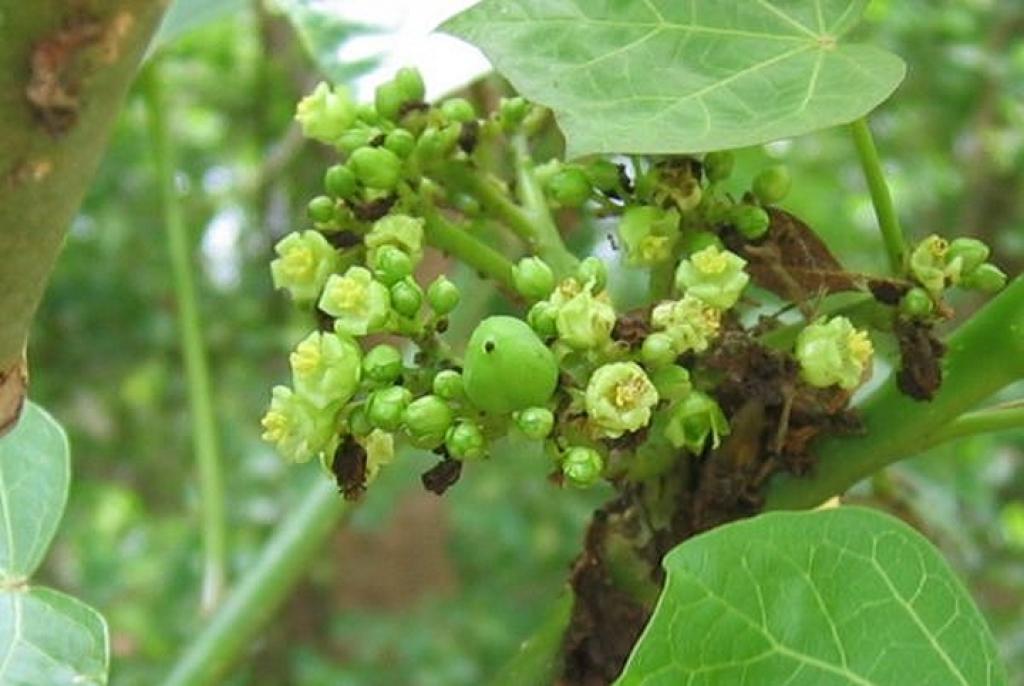
Hope tree species of human energy, the mysterious biodiesel plants: Jatropha [jatropha] also known as Jatropha curcas, Jatropha curcas, green jade tree, gypsum, Liangtong, Euphorbiaceae deciduous shrubs or small trees. It is a photophilic plant, because its roots are strong and developed, has a strong ability to resist drought and barren oil crops, and because branches, trunks, roots near fleshy, soft tissue, water content, pulp, toxic and not easy to burn and pest resistance. It is native to America and is now widely distributed in subtropical and dry hot valley regions. It has been introduced in China for more than 300 years. Seeds in the wild state of dry-hot valleys are usually one-cropped a year, but few are two-cropped a year. Branches and stems have the ability of regeneration. The germination rate of seeds is more than 90%. Jatropha curcas grows rapidly and has strong vitality. In some places, a continuous forest community can be formed. It is not only easy to be afforested artificially, but also has strong natural regeneration ability. It can grow on arid, barren and degraded soil. It is suitable for planting in dry hot valley area where rainfall is scarce and conditions are bad. It is the main choice tree species to protect water and soil, prevent desertification and improve soil. Jatropha curcas L. has strong reproductive ability, dense branches and leaves, woodland closed quickly, deciduous leaves rot easily and inflammable, and strong ability to improve soil. Jatropha curcas growing on steep slopes has become a good biological fire isolation belt. Jatropha curcas fruit can be put into operation in 3 years, and in 5 years. The oil content of Jatropha curcas kernel is 50-60%, and the modified jatropha oil can be applied to all kinds of diesel engines. At present, the dry fruit yield of Jatropha curcas is 600 – 800kg/ mu, and the average yield is about 660kg/ mu.
Meanwhile, Jatropha curcas can increase soil organic matter, improve soil structure, and protect soil and fertilizer. In addition, it will also play an important role in purifying air and reducing natural disasters. Jatropha curcas has high economic value and is recognized as a bioenergy tree in the world. The seed kernel is the traditional soap and lubricating oil raw material, and has the diarrhea and emetic effect, the oil withered can be used as pesticide and fertilizer. Jatropha curcas L. is a promising biodiesel plant species with high oil content in its seeds. It is a good material for biodiesel production. It is called “golden tree” and “diesel tree” by biomass energy experts. The oil residue can be used as chemical and biological pesticide raw materials; the nitrogen-rich seed coat residue is an excellent plant fertilizer; the leaf extract has many forms of chemical active ingredients, and has a wide range of medical value, such as the ketone compounds of Eucalyptus is a systematic development. Antibacterial, antiviral, anti AIDS, anti diabetic, anti-tumor medicinal raw materials. Therefore, the plant is a combination of biological pesticides, bio-medicine, bio-fuel, bio-fertilizer, chemical raw materials, oil, dense source plants, water and soil conservation in one, with economic, social and ecological benefits, a unique advantage of high-quality economic trees, with broad prospects for development. Biodiesel is a clean and renewable energy. It refers to the fatty acid methyl ester produced by transesterification of vegetable oils with methanol. It is a clean biofuel, also known as “renewable fuel” and “green diesel”. In recent years, great progress has been made in the study of using jatropha oil as fuel. The modified jatropha oil can be used in various diesel engines, and is superior to domestic zero diesel oil in key technologies such as flash point, solidification point, sulfur content, carbon monoxide emission and particle number, reaching Euro-2 emission standard. To this end, Jatropha curcas is known as biodiesel tree. Pure jatropha oil can be used for cooking, lighting or power generation. A range of by-products include glycerin for cosmetics and reprocessed jatropha seed cakes that can be used as organic fertilizers. Jatropha curcas can form seeds in more than 30 years from second years. A mature Jatropha tree is planted three times a year, yielding 5 to 8 kilograms of net seeds each time. Unlike oil, jatropha oil is renewable and biodegradable. Burning jatropha oil or biodiesel made from it is cleaner than burning fossil fuels, which produce less carbon dioxide. “Biodiesel crop plan is coming at the right time.”
Jatropha curcas is made from bark and leaves. The four seasons can be picked and used for many times. The bark, leaves and fruits (including the cake after oil extraction) were used as medicine. The bark of Jatropha curcas is smooth, seeds are oblong, and the seed coat is gray and black. TCM believes that it is cold, dispersing stasis and relieving pain, and it can also treat traumatic injuries and pruritus. Interestingly, some places also use it to treat gastroenteritis. The whole plant of Jatropha curcas is poisonous. Stems, leaves and bark are rich in white milk, containing a large number of toxic proteins. The highest concentration of seed poison protein. Its toxic protein is similar to ricin. The seeds also contain a small amount of cyanogen hydrocyanic acid and tetramethylpyrazine. Toxic protein has a strong gastrointestinal irritation, and can even lead to hemorrhagic gastroenteritis.